The Sea to Summit Camp Plus Self-Inflating Mat is more or less self-inflating, very thick, suitable for camping in all seasons, and compact and light enough even to be carried in the backpack.
I ordered the wide-regular version of this sleeping pad and took it with me in the Alps for testing. On some tours at high elevations my tent was on pure rock and at temperatures around zero degrees Celsius, but I was very comfortable with this pad and did not feel the ground at all.
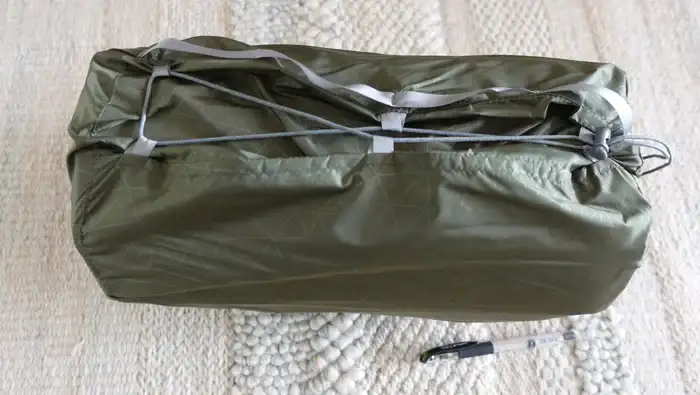
Key features & benefits
- Self-inflating.
- Thick.
- For all seasons.
- Backpack portable.
- Pillow Lock System.
- Very good price.
What is in the name
If you follow the Sea to Summit brand, the you probably know that they have the Sea to Summit Camp Self-Inflating Mat. But they have launched this Plus version which is much thicker and with a slightly higher R-Value.
It is also much heavier and bulkier as you might expect, but it provides great comfort regardless of the surface where you use the pad.
The pad is self-inflating, and this means that the inner is an open-cell foam. They have made it with what they call the Delta Core technology. The meaning is simply that they have cut out a large portion of the foam, up to 40%, creating delta-shaped channels in the pad. The picture shows how they look:
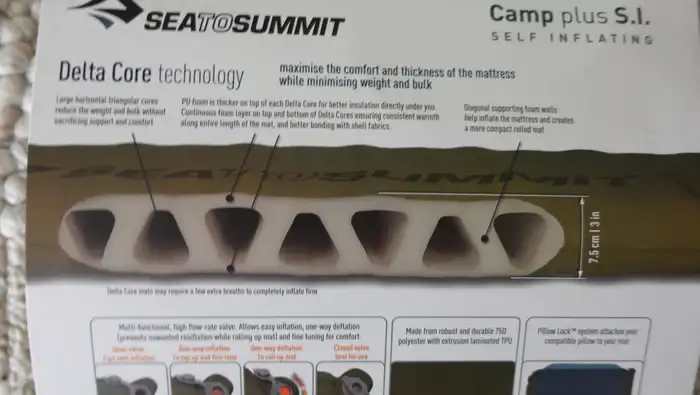
With such large channels, the pad does not self-inflate well, so you have to blow quite an amount of air to make it firm enough.
The valve
The valve is described as multi-functional, though I would say a bit primitive for such a brand. But they describe the pad as an entry-level product. The valve is low profile, and designed to allow easy attachment of a pump if you use it.
It includes a one-way opening to prevent air loss before you seal the valve. You can flip it over and use for deflation as well and the air will not go back inside in the process of rolling the pad.
For rapid initial self-inflation you open it fully as in the pictures on the left below. There is also a fine tune button to adjust for comfort.
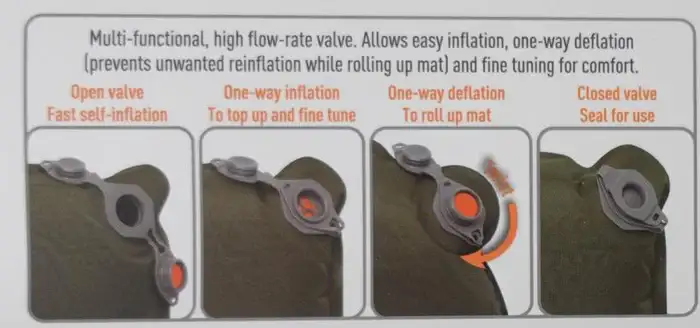
The materials
The mentioned valve looks like a rubber or perhaps silicone, I am not completely sure. The pad fabric is quite strong and durable, they write this is a 75D polyester with extrusion laminated TPU.
According to their statement, it is the Sea to Summit brand that pioneered this technology in outdoor products. Again from their statements, liquid thermoplastic urethane is applied to the face fabric through an extrusion head, where it bonds permanently. As they claim, this makes the pad more reliable and longer-lasting.
There is also what they call the Pillow Lock System. This is a set of self-adhesive hook-and-loop patches, they are supplied with all Sea to Summit sleeping mats. The picture below shows them in my package in the moment I unpacked the pad:
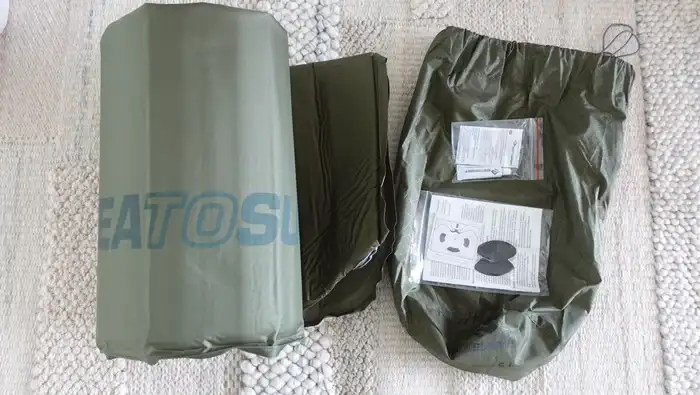
When you attach it to the mat, they will secure your pillow and prevent it slipping, but apparently they will not snag on clothing or other lightweight fabrics.
All Sea to Summit Pillows are compatible with this system. If you have your own pillows that are not from this brand, you can still use their Pillow Lock system by adding their Aeros Pillow Case.
You also get a repair kit for easy puncture repair in the field, it is visible in the picture above.
My testing of the Sea to Summit Camp Plus SI pad
In my previous pad unpacking video I mentioned I would take it with me to the mountains. This is indeed what I did, I went on a 5-weeks tour in the Alps and I have used this sleeping pad in a variety of situations. You will see a couple of them in the video below.
I had it with me on my tour to Cima delle Nove, so I carried it to the Sant Antonio pass (Ju de Sant Antone, 2466 m, 8091 ft), and slept on rocks. The picture below shows the exact spot where I slept, it is taken next morning when I was packing to continue to the summit.
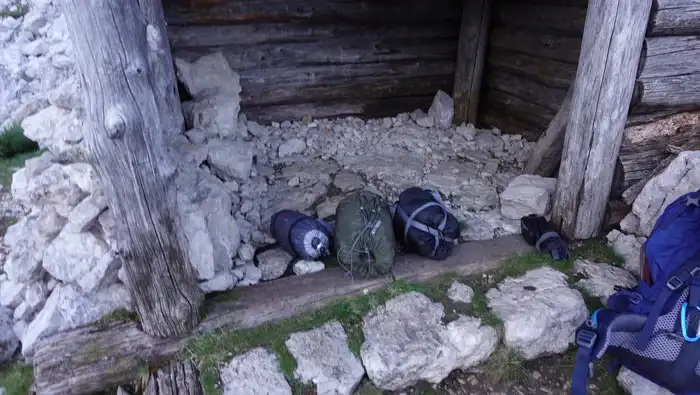
I can tell you I was completely comfortable and did not feel the rough ground at all. During the night the temperature was around zero degrees Celsius, and I was literally in the clouds.
Please see more in my video here where I talk about the pad and show a couple of places where I used it in the Alps:
Who is it for
Regarding climate and seasons, with such a thick foam core and air trapped in it and the mentioned channels, the official R-Value is 4.3. This makes the pad warm enough for almost any environment, except the coldest one.
Regarding the size, they make it in four different sizes and shapes, two rectangular and two tapered mummy-type, see the picture below. This implies very different dimensions and other numbers like the weight and packed size.
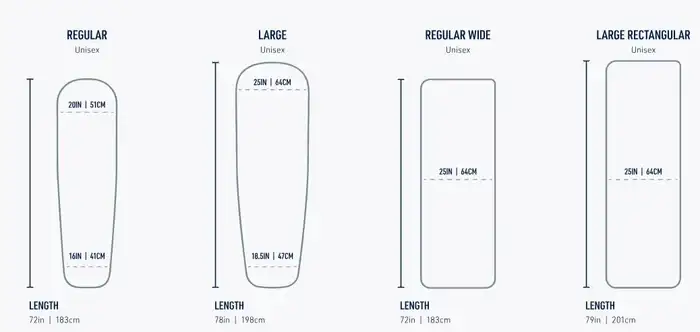
My own pad is rectangular regular-wide (RW). It is a bit bulky and not particularly light, but this is what I wanted. I needed a pad that would be comfortable on any surface, and this is indeed so.
Of course I have yet another and much lighter self-inflating pad, but it is much narrower and only 2.5 cm thick, so the comfort is beyond comparison.
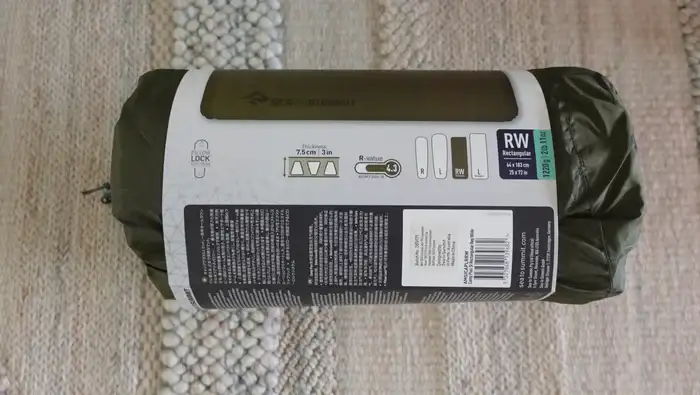
Regarding the weight, the differences between the four options are substantial as you see from the picture below.
My RW version is far from light, but this is a pad with a great R-value and very thick, so I am willing to carry such a weight. You might want to compare it with the REI Co-op AirRail Plus Sleeping Pad from my another text.
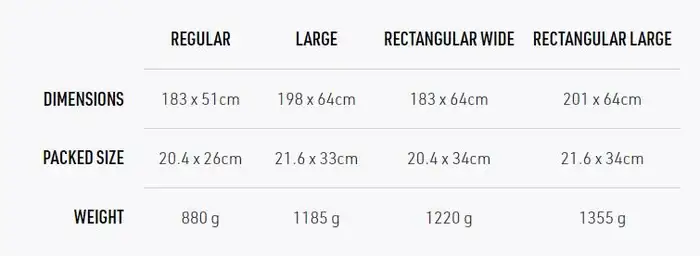
Regarding the packed size, the pad is indeed bulky and you need a bigger backpack for it. I was using my Deuter Futura pack on the tours when this pad was with me.
Note that the carry bag is very nicely designed, with two separate cinch cords, a daisy chain, and a grab pocket on the narrow side, see how it looks:
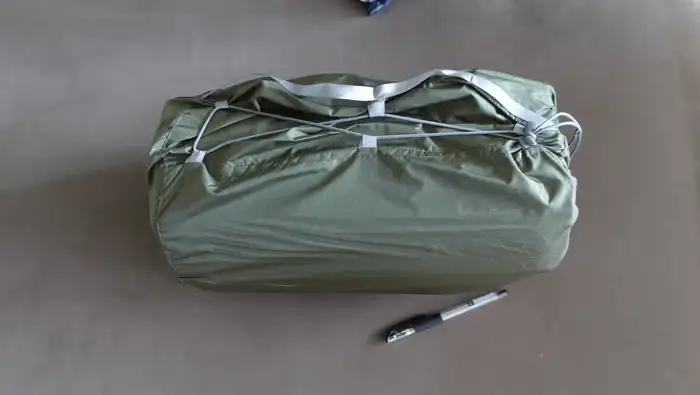
Regarding the price, it is more than fair for such a great outdoor product and from such a renown brand. You have several links below so please check from your side and compare.
Specifications
- Type: self-inflating.
- Weight (my own measurement): 2.79 lb (1265 g).
- Dimensions for RW version (my own measurement): 77 x 25 in (183 x 64 cm).
- Thickness: 3 in (7.5 cm).
- Official R-value: 4.3.
- Packed size, my own measurement (L x D): 13.8 x 7.1 in (35 x 18 cm).
- Warranty: They offer a lifetime warranty for all their products, so you know what you are buying. It is best to follow this link to read more.
Addition: What are the differences between the Camp Plus SI and the Comfort Plus SI mats?
This is motivated by a question I received in my YT channel. You will see it in the comments of my video given above.
The Sea to Summit Camp Plus SI and Comfort Plus SI mats have the same foam core. But the Camp Plus SI is slightly thinner due to its fabric compressing the foam more.
The main difference lies in the fabrics. The Comfort Plus SI has a 30D woven polyester base and a 30D stretch-knit polyester top, offering a more luxurious feel. The stretch-knit fabric feels cooler in warm weather and warmer in cold conditions.
The Camp Plus SI, on the other hand, uses a more durable 75D woven polyester for both the top and bottom.
In terms of R-Values, the Camp Plus SI has a slightly higher rating, but the difference is minimal, 4.3 and 4.1 in the two pads. The Comfort Plus SI weighs a bit more because of the stretch-knit fabric, though this isn’t a major issue for car camping.
In short, if comfort is your priority, choose the Comfort Plus SI. If you prefer durability and are less concerned with the texture, go with the Camp Plus SI.
How about the price? Well, the Comfort Plus SI costs far more, you can check the price on their site.
But how about reliability? Personally, I am of opinion that a stretch material is far more likely to have micro leaks, and I would rather avoid a pad made of it. You can read more in my detailed comparison of the two types of materials, and the comparison of the two pads.
Final thoughts & rating
In the summary of this Sea to Summit Camp Plus Self-Inflating pad review to stress again that this pad is built for comfort and warmth. So this is definitely not the lightest and the most compact option to carry in the backpack. But if a good sleep in the camp of any kind is what you need, this is the pad to consider.
As shown in the text above, there are big differences regarding the weight and packed size among the four versions. But they are all of the same thickness so you can go for a lighter option and still have a thick pad that will separate you from a rough ground.
I have tested it in real mountaineering environment, and I can warmly recommend it. It is included in my list of best self-inflating camping pads, but it is more than that. You can carry this pad in the backpack, and it can also be transported on a bicycle or motorbike.
The R-value of 4.3 is high enough to be included also in my list of best cold weather sleeping pads, but I have not used it in extreme condition.
Below you can see how I rate it against my usual rating criteria so that you can easily compare it with other items of this type:
BEST PLACEs TO BUY
For more options, please check under the category Sleeping Pads.
Subscribe to my weekly newsletter, this will keep you informed because I add texts here regularly. Let me know if you have questions or comments, there is a comment box below. Have a nice day.

Leave a Reply